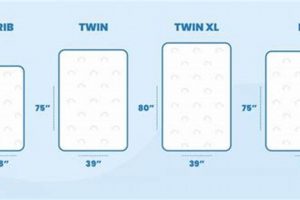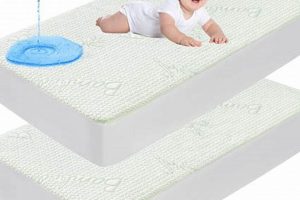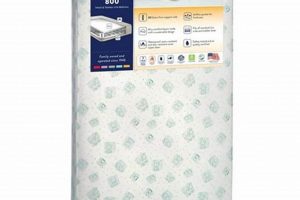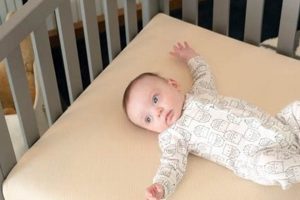A sleeping surface designed for compact infant beds, it facilitates air circulation to help regulate a baby’s temperature and minimize the risk of overheating. Such products typically incorporate materials like open-cell foam, specialized fabrics, or interwoven structures that promote airflow. For instance, a mattress employing a three-dimensional spacer fabric allows air to move freely within the mattress core and around the infant.
The value of these products lies in their contribution to safer sleep environments. Enhanced airflow can help reduce the potential for moisture buildup and maintain a more consistent temperature. This is particularly important given recommendations surrounding infant sleep safety, which emphasize avoiding overheating as a factor linked to sudden unexpected infant death. Historically, concerns about infant suffocation and re-breathing exhaled air have driven innovation in mattress design, leading to the development of more permeable options.
The subsequent sections will delve into specific construction materials, safety standards and certifications, cleaning and care considerations, and factors to consider when selecting one for a miniature crib.
Selecting a Breathable Mini Crib Mattress
This section provides essential guidance for individuals seeking a sleeping surface designed for smaller cribs, focusing on factors impacting infant safety and comfort.
Tip 1: Prioritize Airflow. Examine the mattress construction, focusing on materials and design elements that promote ventilation. Open-cell foam, spacer fabrics, and interwoven structures are often indicative of enhanced breathability.
Tip 2: Evaluate Safety Certifications. Confirm that the mattress meets or exceeds relevant safety standards. Look for certifications such as GREENGUARD Gold, which indicates low chemical emissions, or CertiPUR-US, which verifies foam composition.
Tip 3: Assess Firmness. A firm sleeping surface is crucial for infant safety. Avoid mattresses that are excessively soft or allow the infant to sink in, as this can increase the risk of suffocation.
Tip 4: Consider Mattress Cover Material. Opt for a cover made from a breathable, hypoallergenic fabric. Cotton or bamboo are often suitable choices. Ensure the cover is removable and washable for convenient cleaning.
Tip 5: Verify Dimensions. Carefully measure the interior dimensions of the mini crib and select a mattress that fits snugly. Gaps between the mattress and crib sides can pose a safety hazard.
Tip 6: Research Cleaning Protocols. Inquire about the recommended cleaning procedures for the mattress. Regular cleaning helps maintain a sanitary sleep environment and prolong the product’s lifespan.
Tip 7: Compare Warranty Information. Review the manufacturer’s warranty to understand the extent of coverage and the process for addressing potential defects or issues.
Adhering to these guidelines facilitates informed decision-making, optimizing infant comfort and promoting a safer sleep environment within a compact crib setting.
The subsequent discussion will explore specific types of breathable mattresses and address common misconceptions related to their use.
1. Airflow Enhancement
Airflow enhancement is a primary functional characteristic of a breathable mini crib mattress. It represents the designed capacity of the mattress to permit air circulation within its structure and around the infant occupant. This characteristic is not merely a feature; it is a foundational element intended to mitigate potential risks associated with infant sleep, specifically overheating and the re-breathing of exhaled air. For example, mattresses utilizing three-dimensional spacer fabrics create channels for continuous air movement, preventing the accumulation of heat and moisture. Without adequate airflow, an infant can experience elevated body temperature, potentially increasing the risk of Sudden Infant Death Syndrome (SIDS).
The implementation of airflow enhancement techniques directly influences the microclimate surrounding the infant. Materials such as open-cell foam and interwoven fiber structures allow for greater permeability compared to traditional closed-cell foam or tightly woven fabrics. This increased permeability facilitates the dissipation of body heat and moisture, creating a more regulated and comfortable sleep environment. The practical application of this understanding is evident in the design and marketing of mattresses that specifically highlight their breathable properties, emphasizing the importance of ventilation for infant well-being. Failure to prioritize airflow enhancement in mattress design can result in an increased risk of thermal stress and discomfort for the infant.
In summary, airflow enhancement is an essential, not merely desirable, component of a breathable mini crib mattress. Its proper implementation directly contributes to a safer and more comfortable sleep environment for infants. Challenges remain in standardizing testing methodologies to accurately quantify breathability and ensuring consistent manufacturing quality across different mattress brands. Further research and development are crucial to refine airflow enhancement technologies and promote a broader understanding of their significance in infant sleep safety.
2. Firmness Requirements
Firmness requirements are intrinsically linked to the safety and functionality of a breathable mini crib mattress. The structural integrity of the sleeping surface is crucial in mitigating the risk of Sudden Unexpected Infant Death (SUID). A mattress that is excessively soft allows an infant to sink into the material, potentially leading to airway obstruction. Therefore, a firm surface is mandated to maintain an open airway and facilitate unrestricted movement. This requirement necessitates careful selection of core materials and construction methods. For example, manufacturers often utilize high-density foam or innerspring systems to achieve the requisite firmness. The connection between the core material and breathability is critical; a dense, non-breathable material, while firm, would negate the intended benefits of airflow. Thus, the implementation of firmness requirements must coexist with the principles of breathability.
The practical application of firmness standards is evident in product testing and certification processes. Regulatory bodies, such as the Consumer Product Safety Commission (CPSC), establish guidelines for mattress firmness to ensure compliance. Mattresses that fail to meet these standards are deemed unsafe for infant use. Furthermore, healthcare professionals consistently emphasize the importance of a firm sleep surface as a cornerstone of safe sleep practices. Educational campaigns directed at parents and caregivers highlight the potential dangers of soft bedding and promote adherence to recommended firmness levels. The successful integration of firmness requirements into a breathable mini crib mattress necessitates a balance between structural support and ventilation.
In summary, firmness requirements are not merely an ancillary consideration but a fundamental component of a breathable mini crib mattress. The implementation of these requirements directly affects infant safety and well-being. Challenges lie in achieving the optimal balance between firmness and breathability, requiring ongoing research and innovation in mattress design and materials. Adherence to established safety standards and consistent communication regarding safe sleep practices are essential for minimizing the risk of SUID and promoting a healthy sleep environment for infants.
3. Material Composition
Material composition is a critical determinant of a mini crib mattress’s breathability, safety, and overall suitability for infant use. The selection and arrangement of materials directly influence airflow, support, hygiene, and the potential for exposure to harmful chemicals.
- Foam Type and Density
The type of foam used, whether polyurethane, memory foam, or plant-based foam, significantly affects airflow. Open-cell foam structures promote ventilation compared to closed-cell varieties. Density impacts firmness and support, crucial for preventing infant sinking and maintaining a safe sleep position. Higher density foams, while firm, can restrict airflow if the cell structure is not optimized for breathability.
- Fabric Covers and Layering
The composition of the mattress cover, often cotton, bamboo, or polyester blends, plays a role in breathability and moisture wicking. Natural fibers like cotton and bamboo offer better airflow and moisture absorption compared to synthetic options. The layering of materials within the mattress construction can either enhance or impede breathability, depending on their arrangement and permeability.
- Fire Retardant Treatments
Regulations mandate fire retardancy in mattresses, but the methods employed can impact safety and air quality. Certain chemical fire retardants have raised concerns about potential health risks to infants. Some manufacturers opt for inherently fire-resistant materials like wool or silica, avoiding the use of potentially harmful chemicals. The choice of fire retardant method should be carefully considered to balance safety with potential chemical exposure.
- Adhesives and Bonding Agents
Adhesives used to bond mattress components can release volatile organic compounds (VOCs), impacting indoor air quality. Low-VOC or water-based adhesives minimize this risk, contributing to a healthier sleep environment. The type and quantity of adhesives used should be evaluated to ensure minimal off-gassing and adherence to safety standards.
The interplay between these material components determines the overall performance and safety profile of a breathable mini crib mattress. A conscientious selection process, focusing on breathable materials, non-toxic treatments, and low-VOC adhesives, is paramount in providing a safe and comfortable sleep environment for infants.
4. Safety Certifications
Safety certifications serve as verifiable endorsements of a breathable mini crib mattress’s adherence to established safety standards and performance criteria. These certifications offer consumers an objective assessment of a product’s quality and its potential impact on infant health and well-being. The presence of relevant certifications provides a degree of assurance regarding the mattress’s composition, emissions, and structural integrity.
- GREENGUARD Gold Certification
This certification indicates that a breathable mini crib mattress has undergone rigorous testing for chemical emissions, including volatile organic compounds (VOCs), phthalates, and other harmful substances. Mattresses bearing the GREENGUARD Gold label meet stringent emission standards, ensuring that they contribute to healthier indoor air quality and minimize potential respiratory irritation or allergic reactions in infants. For example, a mattress with this certification would have been tested and verified to emit low levels of formaldehyde, a known carcinogen.
- CertiPUR-US Certification
The CertiPUR-US program certifies that the foam components within a breathable mini crib mattress have been tested for prohibited substances, including ozone depleters, heavy metals, and certain flame retardants. This certification assures consumers that the foam materials used in the mattress meet specific criteria for content, emissions, and durability, promoting a safer and more environmentally responsible product. An example would be the verification that the foam does not contain mercury, lead, or other heavy metals that could pose a risk to infant health.
- Oeko-Tex Standard 100 Certification
This certification applies to the textile components of a breathable mini crib mattress, such as the cover fabric. The Oeko-Tex Standard 100 ensures that the textiles have been tested for harmful substances and meet specific human-ecological requirements. This certification guarantees that the fabric is safe for contact with infants’ sensitive skin and minimizes the risk of allergic reactions or skin irritation. For example, a mattress cover with this certification would be free from allergenic dyes, pesticides, and formaldehyde.
- Consumer Product Safety Commission (CPSC) Compliance
While not a certification, compliance with CPSC standards is a legal requirement for all crib mattresses sold in the United States. The CPSC sets mandatory safety standards for crib mattresses, including requirements for firmness, size, and flammability. Manufacturers must demonstrate compliance with these standards through rigorous testing and documentation. A compliant breathable mini crib mattress would meet the CPSC’s requirements for firmness to reduce the risk of suffocation and would be appropriately sized to prevent gaps between the mattress and crib sides.
These safety certifications collectively provide a multifaceted assessment of a breathable mini crib mattress’s safety and quality. They encompass chemical emissions, material composition, and adherence to established safety standards. Consumers can leverage these certifications as valuable tools for making informed purchasing decisions, prioritizing infant health and well-being when selecting a sleeping surface for a mini crib. The absence of relevant certifications should raise concerns and warrant further investigation into the mattress’s safety profile.
5. Size Compatibility
Proper size compatibility is not merely a convenience but a fundamental safety imperative when selecting a breathable mini crib mattress. Dimensional discrepancies between the mattress and the crib frame can introduce hazards that compromise infant safety. A lack of precise fit can lead to entrapment risks, undermining the intended benefits of breathability and other safety features.
- Gap Formation and Entrapment Risks
Significant gaps between the mattress edges and the crib rails create potential spaces where an infant’s limbs, head, or body can become lodged. Entrapment can lead to suffocation, strangulation, or other injuries. To prevent such occurrences, a snug fit is essential, ensuring minimal space for an infant to become trapped. For instance, a mattress that is even a few centimeters too narrow can create a dangerous gap along the crib sides.
- Compromised Mattress Support
A mattress that is too small for the crib frame may not receive adequate support, leading to uneven weight distribution and potential sagging. Sagging can create an unlevel sleeping surface, increasing the risk of rolling and potential positional asphyxia. Proper size compatibility ensures that the mattress is fully supported by the crib frame, maintaining a firm and even sleeping surface.
- Increased Risk of Mattress Movement
A loosely fitting mattress is more prone to shifting or sliding within the crib, particularly as the infant moves. This movement can further exacerbate gap formation and increase the risk of entrapment. A properly sized mattress remains securely in place, minimizing the potential for hazardous movement.
- Impact on Breathability Features
While size compatibility does not directly create breathability, a very loose fit can, in some instances, indirectly affect the feature if the mattress were to move and cover ventilation holes on the crib itself or compress against a crib side not allowing air flow. Therefore, it is essential to check overall the feature function while making size compatibility a main point.
In summation, size compatibility is an indispensable factor in ensuring the safety and efficacy of a breathable mini crib mattress. Accurate measurements and adherence to manufacturer specifications are essential to mitigate the risks associated with ill-fitting mattresses, thereby promoting a safer sleep environment for infants. Size compatibility affects breathability indirectly but needs consideration for air to function as it stated.
6. Cleaning Procedures
Maintaining the cleanliness of a breathable mini crib mattress is paramount for infant health and hygiene, directly influencing the mattress’s lifespan and functional performance. Neglecting proper cleaning protocols can compromise the mattress’s breathability features and potentially expose the infant to allergens and pathogens.
- Regular Vacuuming
Vacuuming the mattress surface regularly removes dust mites, pet dander, and other allergens that can accumulate over time. Using a vacuum with a HEPA filter further enhances allergen removal. Routine vacuuming helps maintain a cleaner sleep environment and prevents the buildup of particles that can obstruct airflow within the mattress’s breathable structure. For instance, a weekly vacuuming schedule can significantly reduce allergen levels compared to infrequent cleaning.
- Spot Cleaning for Stains and Spills
Promptly addressing stains and spills is essential to prevent permanent damage and microbial growth. Gentle cleaning solutions, specifically designed for infant products, should be used to avoid harsh chemicals that could irritate the infant’s skin or respiratory system. Blotting the stain rather than rubbing minimizes damage to the mattress fibers and prevents the stain from spreading. For example, a mixture of mild detergent and water can effectively remove many common stains.
- Mattress Cover Removal and Washing
Many breathable mini crib mattresses feature removable covers that can be machine washed. Following the manufacturer’s instructions for washing and drying the cover is crucial to avoid shrinkage or damage to the fabric. Regular washing of the cover eliminates allergens and keeps the sleeping surface fresh and clean. For instance, washing the cover on a gentle cycle with cold water and tumble drying on low heat helps preserve its integrity.
- Disinfection Protocols
In cases of illness or contamination, disinfecting the mattress may be necessary. However, harsh chemical disinfectants should be avoided due to potential health risks. Instead, consider using a diluted bleach solution or a commercially available disinfectant specifically formulated for infant products, following the manufacturer’s instructions carefully. Thoroughly rinsing and drying the mattress after disinfection is essential to remove any residual chemicals. Exposure to sunlight can also aid in the disinfection process.
Proper cleaning procedures are integral to maintaining the hygiene and functionality of a breathable mini crib mattress. Consistent cleaning, using appropriate products and techniques, ensures a safe and healthy sleep environment for infants. Failure to adhere to these protocols can lead to the accumulation of allergens, microbial growth, and compromised breathability, potentially jeopardizing the infant’s well-being. Cleaning can affect feature’s function so proper ways should be taken into consideration to ensure the mattress stays breathable.
7. Cover Breathability
Cover breathability is a crucial aspect of a sleeping surface designed for miniature cribs, directly influencing its capacity to facilitate airflow and contribute to a safe sleep environment for infants. The cover acts as the initial interface between the infant and the mattress, dictating the passage of air, moisture, and heat.
- Fiber Selection and Air Permeability
The choice of fiber significantly impacts the cover’s breathability. Natural fibers, such as cotton or bamboo, generally offer superior air permeability compared to synthetic alternatives like polyester. The weave and construction of the fabric also contribute; a looser weave allows for greater airflow, while a tighter weave restricts it. For example, an organic cotton cover with an open weave facilitates heat dissipation, reducing the risk of overheating. Conversely, a tightly woven polyester cover may impede airflow, potentially leading to moisture buildup and discomfort.
- Moisture Wicking Properties
The ability of the cover to wick away moisture is integral to maintaining a dry and comfortable sleep surface. Moisture buildup can create a breeding ground for bacteria and contribute to skin irritation. Fabrics with moisture-wicking properties draw perspiration away from the infant’s body, promoting evaporation and preventing excessive dampness. Microfiber blends and certain bamboo fabrics are commonly used for their moisture-wicking capabilities, ensuring a drier and more hygienic sleeping environment.
- Impact on Mattress Core Breathability
The cover’s breathability directly influences the effectiveness of the mattress core’s breathability features. If the cover restricts airflow, the core’s ventilation properties are compromised. A breathable cover allows air to circulate freely through the entire mattress system, optimizing temperature regulation and reducing the risk of overheating. For instance, a cover made from a breathable mesh fabric enhances the effectiveness of an open-cell foam core, allowing for maximum airflow.
- Hypoallergenic Properties and Skin Sensitivity
Infants’ skin is particularly sensitive, making hypoallergenic properties an important consideration for mattress covers. Materials that are less likely to cause allergic reactions or skin irritation are preferred. Organic cotton and bamboo are often favored for their hypoallergenic qualities, minimizing the risk of contact dermatitis or other skin conditions. Certifications like Oeko-Tex Standard 100 further ensure that the cover is free from harmful substances that could irritate sensitive skin.
In conclusion, the selection of a breathable cover is integral to maximizing the benefits of a sleeping surface designed for miniature cribs. The fiber choice, weave, moisture-wicking properties, and hypoallergenic qualities all contribute to a safe, comfortable, and hygienic sleep environment. A cover that complements the breathability features of the mattress core is essential for optimal performance and infant well-being.
Frequently Asked Questions
This section addresses common inquiries regarding these mattresses, providing clarity on their features, safety aspects, and proper usage.
Question 1: What constitutes a breathable mini crib mattress?
It is a sleeping surface engineered for compact infant beds, specifically designed to promote air circulation. Construction materials and design, such as open-cell foam or spacer fabrics, facilitate ventilation to help regulate infant body temperature and minimize overheating risks.
Question 2: How does a breathable mini crib mattress enhance infant safety?
Enhanced airflow within the mattress dissipates heat and moisture, helping to maintain a consistent temperature and reduce the risk of overheating, a factor associated with Sudden Infant Death Syndrome (SIDS). Breathable designs also minimize the potential for re-breathing exhaled air.
Question 3: What safety certifications should one seek when purchasing a breathable mini crib mattress?
Look for certifications such as GREENGUARD Gold, which indicates low chemical emissions, and CertiPUR-US, which verifies foam composition. Compliance with Consumer Product Safety Commission (CPSC) standards is also mandatory.
Question 4: How does one ensure proper fit when selecting a breathable mini crib mattress?
Carefully measure the interior dimensions of the mini crib and select a mattress that fits snugly. Gaps between the mattress and crib sides pose a significant safety hazard and must be avoided.
Question 5: What are the recommended cleaning procedures for a breathable mini crib mattress?
Regular vacuuming removes dust and allergens. Spot clean stains with mild detergent and water. If the mattress has a removable cover, machine wash it according to the manufacturer’s instructions. Avoid harsh chemicals and ensure the mattress is thoroughly dried after cleaning.
Question 6: How can the breathability of a mini crib mattress cover be assessed?
Opt for covers made from natural fibers like cotton or bamboo, known for their air permeability and moisture-wicking properties. Ensure the cover fits snugly but does not overly compress the mattress, hindering airflow. Look for certifications like Oeko-Tex Standard 100, indicating the fabric is free from harmful substances.
In summary, a breathable mini crib mattress is more than a comfort item; it’s a safety-focused product. Rigorous evaluation of safety certifications, material composition, and proper fit are essential to ensure a safe sleep environment for infants.
The next segment will address potential misconceptions regarding breathable mini crib mattresses and offer additional guidance for informed decision-making.
Conclusion
The preceding discussion has explored critical aspects of breathable mini crib mattresses, emphasizing safety, functionality, and construction. Key considerations encompass airflow enhancement, firmness requirements, material composition, safety certifications, size compatibility, cleaning procedures, and cover breathability. These elements collectively determine a mattress’s suitability for providing a safe and comfortable sleep environment for infants within a compact crib setting.
The implementation of breathable mini crib mattress technology represents a significant advancement in infant sleep safety. Continued adherence to established safety standards, coupled with ongoing research and development, is paramount. A commitment to informed decision-making and proactive safety measures will contribute to the well-being of infants during this crucial developmental stage.







